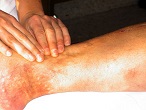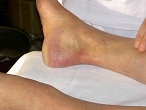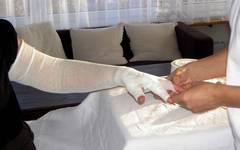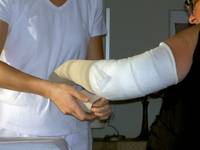Lymphatic drainage massage & integral oedema therapy
Manual Lymphatic Drainage Massage (MLD)
The speed of the lymphatic flow is activated by rhythmical, kneading circular hand movements
- The permeability of the tissue is improved
- Fluid flow is stimulated by improving lymphatic contractillity
- Local connective tissue is more easily provided with nutrients
- Waste products are removed local swellings, water retention (so called oedema) are removed, congestions are cleared
- Skin texture gets restored
- Fibrosclerotic tissue gets reduced
- The immune system is improved
- Manual Lymphatic Drainage Massage (MLD) works at tissue level, in contrast to the classic massage which works at muscle level, MLD removes fluid build up from tissue without overloading the circulation (classic massage activates blood circulation).
Selection of conditions for which MLD is recommended:
- Primary and secondary lymphoedema (lymphedema)
- swollen limbs
- Lipoedema
- Cellulite
- Chronic venous insufficiency (varicose veins, spider veins)
- Leg ulcers
- poor wound healing
- Post-traumatic oedema after surgical procedures
- Sport injuries (such as bruising, sprains)
- Jaw surgery
- Carpal tunnel syndrome
- Bone marrow oedema (evidenced by magnetic resonance imaging MRI)
- Poorly healing wounds
- Scars
- Congestions due to pregnancy
- After birth or caesarean section
- Premenstrual syndrome
- Chronic inflammatory conditions (e.g. Arthrose, Arthritis)
- Fibromyalgia
- Fibrosis of the tissue
- Various chronic ailments (eg. Allergies)
- Chemotherapy (MLD only as additional therapy)
- Tinnitus
- Whiplash, cervical spine syndrome
- Migraine
- Obesity
- Congestion of the abdominal lymphatic vessels (often seen as belly)
- Stress, Burn Out Syndrome
- Convalescence
- Optimal preparation for physiotherapy
Oedema Therapy – Complex Decongestive Therapy – Multi-layer compressive bandaging
CDT consists of an intensive regime of multi- layer compression bandaging after MLD treatment. It helps to keep the fluid moving; it reduces limb volume and improves shape in order that compression garments can be fitted.
The bandaging creates a boundary compartment in which the lymphatics are perfectly stimulated during muscular use and fibrosclerotic tissue gets reduced as well. Decongestive exercises while wearing compression garments improve the success of therapy even more.
Compression garments
During therapy a custom-fitted compression stocking or sleeve might replace the compression bandaging.
Advantages:
- The compression garment can be put on and taken off by the patient himself (in contrast to compression bandaging)
- It weighs less and is therefore more convenient then compression bandages.
Today, compression garments are available in different materials and colours.
A wide range of fitting aids which facilitate the use of compression garments exist for handicapped people .
Integrated into the therapy are tips on the correct usage of these compression garments.
A useful and convenient addition to classical compression bandaging is Lymphatic Taping.
Naturopathic lymphedema management
A holistic, integrative lymphedema management requires more than pyhsical therapy. The lymphatics are highly interlinked with the tissue metabolism and therefore the naturopathy can help us improving the lymphatics.
Herbal medicine
Various herbal components such as coumarins and flavonoids have shown a positive effect on the lymphatic and venous systems.
The intake of specific medicinal plants in the form of tinctures, medicinal herbal teas or capsules has an positive effect on all lymphatic and venous ailments and disorders. An individually tailored mix of medicinal plants constitutes an ideal complement to MLD.
All recommended mixtures, tinctures, teas, capsules and alkaline mineral salts are available in specialized pharmacies or chemists.
Dietetics
Chronic food intolerance could lead to water retention in the bodily tissue (so called idiopathic oedema) and could in the long term have a degenerative effect on the soft tissue. For instance cow`s milk-allergies are wide spread. Dietary recommendations in order to improve the lymphatic system are an integrated part of the therapy.
Acid-base-balance
The soft tissue is the nutrient storage-place of the body. During periods of stress, unhealthy diet and lymphatic disorders more nutrients are needed to keep the metabolism in balance. To achieve and maintain good health the soft tissue needs well-established buffer proprieties. Therefore a a diet rich in bases or even alkaline mineral salts is required.
Matrix-Rhythm-Therapy
Rhythmical flow enhances the microcirculation in the connective tissue and improves the tissue-metabolism.







